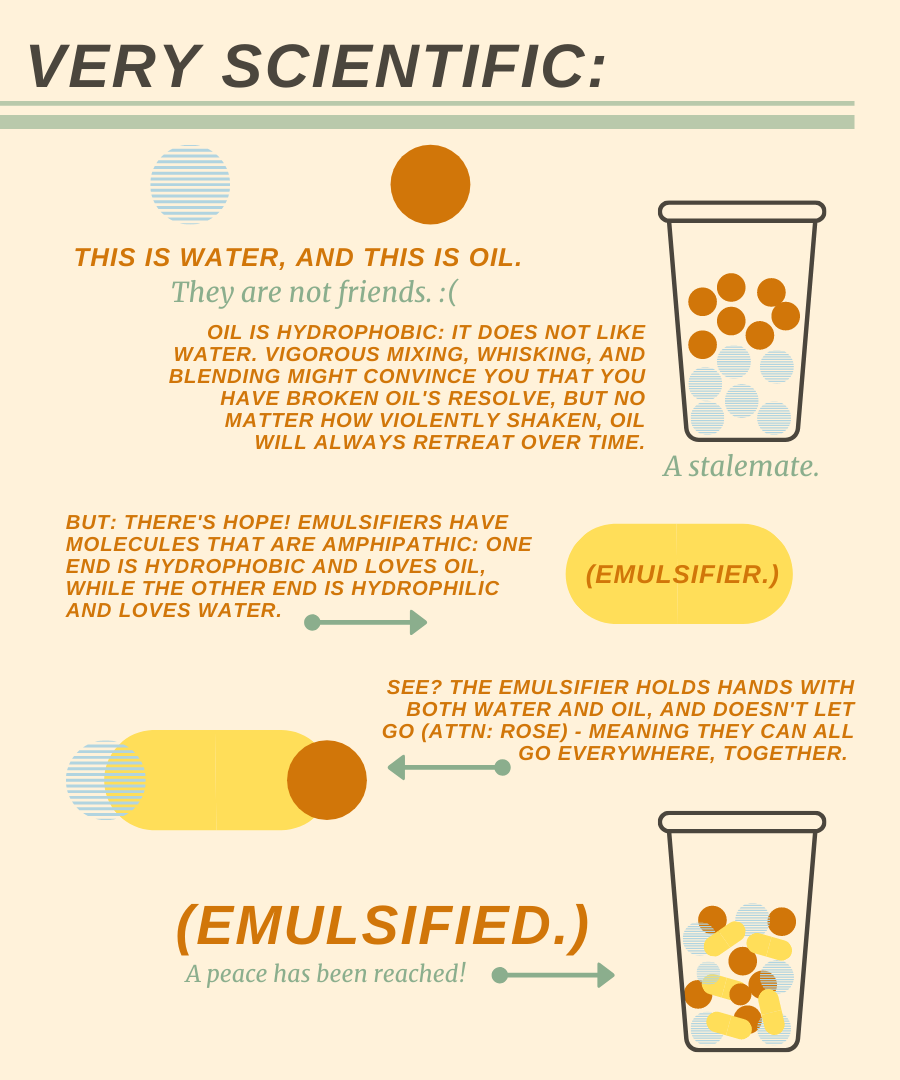Emulsifier In Food for Vegan Cooking
Why It Is Necessary to Incorporate an Emulsifier in Food for Optimum Preference and Top Quality
Emulsifiers play a critical role in food production by making sure the secure mixing of immiscible fluids, such as oil and water. They minimize interfacial stress, which prevents the separation of active ingredients and contributes to a consistent texture. This not just enhances mouthfeel however also affects taste assumption. Comprehending the need of emulsifiers discloses deeper understandings into their function and importance in culinary applications. What implications does this have for food technology and customer choices?
Understanding Emulsifiers: The Fundamentals
Emulsifiers play an important function in food scientific research, acting as representatives that facilitate the mixing of two immiscible liquids, such as oil and water. These substances have both hydrophilic (water-attracting) and hydrophobic (water-repelling) properties, which enable them to maintain solutions. Common emulsifiers consist of lecithin, found in egg yolks and soybeans, and mono- and diglycerides, stemmed from fats.
The Science Behind Emulsification
When two immiscible fluids are combined, the procedure of emulsification becomes basic for accomplishing a stable blend. Emulsification involves spreading one fluid within another, usually oil in water or the other way around. This process happens with mechanical agitation, which damages the larger beads right into smaller sized ones, consequently increasing the area. However, without the visibility of emulsifiers, these beads would certainly integrate, resulting in splitting up.
Emulsifiers are particles with hydrophilic (water-attracting) and hydrophobic (water-repelling) homes. Their distinct structure allows them to reduce the interfacial tension in between both immiscible fluids, maintaining the solution. This stablizing avoids separation and improves the uniformity of structure and flavor. The communications at the molecular degree are necessary for keeping the honesty of the emulsion, making sure that food keep their wanted uniformity and taste. Understanding this science is considerable for food scientists and producers in developing premium food.
Kinds Of Emulsifiers Used in Food
The types of emulsifiers made use of in food can be generally categorized right into synthetic and natural ranges. Usual food emulsifiers, such as lecithin and mono- and diglycerides, play a crucial role in boosting food stability and structure. Comprehending these differences is vital for valuing exactly how emulsifiers add to the total quality of food.
Artificial vs. all-natural Emulsifiers
While both artificial and natural emulsifiers serve the vital function of supporting blends in food, their beginnings and characteristics vary markedly. All-natural emulsifiers, stemmed from plant or animal sources, consist of lecithin, casein, and specific gum tissues. They are typically perceived as healthier choices, attracting customers looking for clean-label products. On the other hand, synthetic emulsifiers, such as mono- and diglycerides, are chemically engineered and might provide boosted stability and capability in a bigger array of applications. These synthetic alternatives can be more cost-efficient and supply consistent top quality. They may evoke hesitation amongst health-conscious consumers. Inevitably, the option in between artificial and all-natural emulsifiers depends upon the wanted high qualities of the food, consisting of appearance, flavor, and shelf-life stability.
Typical Food Emulsifiers
Emulsifiers play an essential role in the food sector, making certain the security and structure of various items. Usual food emulsifiers consist of lecithin, mono- and diglycerides, and polysorbates. Emulsifier In Food. Lecithin, originated from resources like soybeans and egg yolks, is extensively utilized in baked products and delicious chocolates. Mono- and diglycerides, typically obtained from veggie oils, improve the creaminess of margarine and ice lotion. Polysorbates, synthetic emulsifiers, are frequently found in salad dressings and sauces, promoting a smooth uniformity. Various other emulsifiers such as xanthan periodontal and guar gum tissue, both natural thickeners, also add to the desired texture in different food products. Each emulsifier type serves details functions, adding to the total high quality and charm of food items

Role in Food Stability
Food security is significantly influenced by the kinds of emulsifiers used, which assist avoid the splitting up of ingredients in various formulas. Emulsifiers such as lecithin, mono- and diglycerides, and polysorbates play crucial functions in preserving the uniformity of items like dressings, sauces, and gelato. Lecithin, originated from soy or egg yolk, is especially effective because of its all-natural properties, while mono- and diglycerides boost appearance and rack life. Polysorbates, on the various other hand, improve the security of oil-in-water solutions, making them optimal for baked products. The selection of emulsifier relies on the details food application and preferred attributes, making sure that items remain steady, appealing, and of high top quality throughout their intended service life.
Exactly How Emulsifiers Improve Structure and Mouthfeel
Enhancing the sensory experience of food, emulsifiers play an essential duty in improving texture and mouthfeel. These materials help with the uniform distribution of ingredients, enabling a smoother and creamier consistency in items such as dressings, sauces, and gelato. By supporting blends of oil and water, emulsifiers stop splitting up, leading to a cohesive structure that improves the overall consuming experience.
Emulsifiers can change the thickness of food products, adding to a preferable thickness or creaminess. This alteration of structure can influence exactly how food feels in the mouth, affecting fulfillment and enjoyment. Furthermore, by developing a stable emulsion, emulsifiers aid maintain the integrity of the item, guaranteeing that the designated mouthfeel is constantly delivered with time. On the whole, the application of emulsifiers is vital for attaining the best texture and mouthfeel, inevitably elevating the top quality of foodstuff.
The Role of Emulsifiers in Flavor Enhancement
Flavor enhancement in cooking applications commonly pivots on the efficient use emulsifiers. These compounds facilitate the blending of water and oil, permitting the even distribution of flavor compounds within foodstuff. By creating stable solutions, emulsifiers aid to encapsulate and release unstable flavors, improving the overall sensory experience.
On top of that, emulsifiers can improve the understanding of taste by influencing the mouthfeel and structure of meals. A smoother, much more natural item can lead to an enhanced assumption of flavors, making them extra delightful and noticable. Emulsifiers can secure sensitive tastes from degradation, guaranteeing that they continue to be intact throughout processing and storage.
Emulsifiers in Popular Food Products
Just how do emulsifiers add to the appearance and stability of popular food? Emulsifiers play a crucial role in various commonly eaten things. In salad dressings, they assure a smooth mix of oil and vinegar, protecting against separation and boosting mouthfeel. In ice lotion, emulsifiers create a luscious appearance by maintaining air bubbles, resulting in an indulgent and rich product. Baked goods, such as bread and cakes, gain from emulsifiers by improving quantity and crumb structure, resulting in a lighter and much more attractive appearance. In addition, mayonnaise counts on emulsifiers to preserve its thick uniformity and stop oil separation. look at this website Margarine and spreads also utilize emulsifiers to accomplish a spreadable appearance while preserving stability. These examples highlight the considerable impact of emulsifiers on the high quality and pleasure of daily food, emphasizing their importance in modern-day food formulation.
The Future of Emulsifiers in Food Innovation
The future of emulsifiers in food innovation is noted by significant developments in technology, leading the means for new formulations. In addition, the demand for healthier emulsifier options is increasing, motivating researchers to discover all-natural and plant-based choices. Sustainable sourcing techniques are also ending up being essential, as consumers progressively prioritize ecological responsibility in their food options.
Developments in Emulsifier Innovation
As researchers proceed to check out the molecular ins and outs of emulsifiers, considerable advancements are emerging that promise to reinvent food development. Current growths concentrate on creating more reliable and versatile emulsifiers that improve appearance, stability, and taste in different food products. Technologies in biopolymer-based emulsifiers are gaining traction, supplying enhanced sustainability and efficiency over typical read the article options. In addition, improvements in nanotechnology are allowing the design of emulsifiers at the molecular degree, which can result in finer emulsions and boosted sensory experiences. These technical developments are not only enhancing product top quality however likewise expanding the series of applications for emulsifiers in the food market. As these technologies unravel, they are expected to redefine culinary opportunities and consumer preferences in the future.
Much Healthier Emulsifier Alternatives
While conventional emulsifiers have played a crucial role in food production, there is a growing demand for healthier choices that line up with consumer choices for natural components and clean labels. Advancements in plant-based emulsifiers, such as those obtained from flaxseed, sunflower, and soy, have obtained popularity due to their perceived wellness advantages. These options usually contain less ingredients and offer functionality comparable to artificial emulsifiers. Furthermore, components like aquafaba, the fluid from prepared chickpeas, have actually become flexible emulsifying agents, appealing to vegan and health-conscious customers. Emulsifier In Food. The shift in the direction of these healthier emulsifiers not just boosts the allure of food but additionally sustains the trend of transparency in component sourcing, eventually fostering customer count on and complete satisfaction

Lasting Sourcing Practices
Sustainable sourcing methods are ending up being increasingly address crucial in the development of emulsifiers, showing a more comprehensive dedication to environmental obligation within the food sector. Makers are now focusing on the usage of eco-friendly sources, such as plant-based active ingredients, which reduces the carbon footprint related to traditional emulsifiers. This shift not only sustains biodiversity however also advertises moral farming methods that benefit neighborhood neighborhoods. Furthermore, developments in modern technology enable the extraction and handling of emulsifiers with reduced environmental effect. By taking on sustainable sourcing, business improve their brand name photo while fulfilling consumer demand for openness and eco-friendliness. As the food sector continues to develop, the assimilation of sustainable emulsifiers will play a crucial duty fit future innovations, guaranteeing a balance between high quality and environmental stewardship.
Often Asked Inquiries
Are Emulsifiers Safe for Individuals With Food Allergies?
:max_bytes(150000):strip_icc()/Emulsify-58add64f3df78c345bdef91d.jpg)
Can Emulsifiers Affect the Nutritional Value of Food?
Emulsifiers can affect the dietary value of food by improving nutrition absorption or possibly modifying the bioavailability of particular substances. Their effects differ extensively depending on the kind of emulsifier and the general food solution.
How Do Emulsifiers Effect Shelf Life of Products?
Emulsifiers enhance the rack life of products by stabilizing combinations, avoiding splitting up, and reducing perishing. This security aids preserve appearance and flavor in time, inevitably ensuring food stays risk-free and appealing for longer durations.
What Are Common Natural Emulsifiers Discovered in Home Kitchens?
Common natural emulsifiers discovered in home kitchen areas include egg yolks, soy, mustard, and honey lecithin. These components help stabilize blends by minimizing surface tension between oil and water, improving structure and uniformity in different dishes.
Exist Any Problems With Artificial Emulsifiers in Food?
Problems relating to synthetic emulsifiers in food consist of prospective digestive problems, inflammatory responses, and links to excessive weight. Some research studies recommend these additives might interrupt gut microbiota, questioning regarding their lasting effects on health and wellness and health.
Common food emulsifiers, such as lecithin and mono- and diglycerides, play a crucial function in enhancing food stability and appearance. Emulsifiers play an essential duty in the food sector, making sure the stability and texture of various products - Emulsifier In Food. Various other emulsifiers such as xanthan periodontal and guar periodontal, both natural thickeners, additionally contribute to the preferred appearance in various food products. Recent advancements focus on creating more functional and effective emulsifiers that enhance structure, security, and flavor in numerous food items. Emulsifiers can pose risks for individuals with food allergic reactions, as some emulsifiers are acquired from irritants like soy or eggs